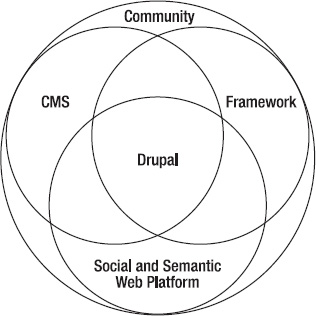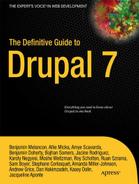Preface: Why Drupal?
Drupal is a great content management system, a powerful framework for web applications, and a cutting edge social publishing platform. Above all, Drupal is more than software—it is a vibrant community of developers, designers, project managers, business innovators, technology strategists, user experience professionals, standards and accessibility advocates, and people who just mess around with stuff until they figure it out.

Figure 1. Drupal as the intersection of web content management system, application framework, and social and semantic publishing platform—encompassed by a diverse community
Drupal Is a CMS for Building Dynamic Web Sites
“The stuff that I am able to build with Drupal … is just mind-blowing.”
—Merlin Mann of 43folders.com
With Drupal, you get all the features of a powerful content management system, or CMS—user login and registration; definition of types of users and content; different levels of permissions; content creation, editing, categorization, and management; syndication and aggregation—out of the metaphorical box. In addition to this core functionality, there's an expanding universe of additional functionality available from the rising influx of community contributions.
The Views module (see Chapter 3) allows you to organize and display content in any number of ways. The Groups module (see Chapter 5) can be used to create online workgroups, discussion groups, and more. Drupal Commerce (see Chapter 25) allows you to configure full online stores. This is just a small sampling of the powerful extensions available to Drupal through contributed modules (see Chapter 4 for some more). From theming examples to make your site look better (see Chapters 15 and 16) to command line tools (Chapter 26) to powerful search (Chapter 31), if you want to build it in Drupal, it's very likely that someone already has—and has contributed the code or the instructions back to the community. If you want to go beyond functionality that anyone has contributed yet by writing your own modules (Chapters 18 to 24), there will be a lot of help out there for that, too. (See Chapter 9 for getting the most out of Drupal by participating in the community and Chapter 38 for contributing to this ecosystem yourself.)
Drupal is written in PHP with a great deal of JavaScript (mostly using the JQuery library) for the front-end experience, and it uses a database such as MariaDB/MySQL or PostgreSQL to store both content and configuration. Of course, by doing enough custom coding with these or other programming languages and databases, a developer can do anything a Drupal site can do. But why? Using Drupal saves site builders from reinventing the wheel, allowing a focus on achieving their goals. Drupal takes you where you drive it, without you having to build a car first.
“I needed a system that was able to take lots of different types of structured content and slice and dice it in different ways. [...] I had thought of a really cool way to organize my data and then I realized I would need to write a CMS on top of that, and I didn't want to spend the next eight years of my life writing it. And I found out a bunch of people had spent the last eight years of their life writing it, and it was called Drupal; so I was thrilled.”
—Jeff Eaton
Drupal Is an Application Framework
“Yes, Drupal is what you need it to be.”
—Wim Mostrey
Drupal has become so solid at its core, so extensible, and so powerful for building different kinds of web sites that it is more than a CMS: it is a platform for developing serious web applications. Each major release includes better APIs (Application Programming Interfaces; how code talks to code) and other powerful features that take it beyond being a CMS.
Drupal is used as the basis for different types of applications, from smart phone and Facebook apps to web sites with complex business logic (nysenate.gov/mobile, nysenate.gov/mobile, zagat.com) to social media and retail-ready software as a service (buzzr.com). Drupal can also be found in such non-CMS roles as the front end for Java-based applications and the back end for AJAX or Flash-driven front ends.
Where this distinction between framework and CMS or other product can mean the most to you is the growth of distributions built on Drupal to solve specific use cases. Examples include OpenAtrium (openatrium.com) for team intranets, Drupal Commons (drupalcommons.com) for social business, OpenPublish (openpublishapp.com) for online publishers, and OpenScholar (scholar.harvard.edu) for personal academic and research web sites. (See Chapter 34 for more on distributions, including how to create your own.)
Drupal Is a Social and Semantic Web Platform
“If you have to be the center of the world, you will either succeed and own everything, or you will die.”
—Sir Tim Berners-Lee
The ideal of the social and semantic web embraces a vision for a future where information isn't trapped in a single web site or company. Instead, your information and that which others share with you is under your control and available among multiple platforms and devices. Sites working together offer a way out of a dystopian world where control of connections among people and data is all or nothing. Drupal and its support for RDF (Resource Description Framework) help make this better future possible.
RDF helps label data in a way that computers can universally understand, so that they can do intelligent things with data from diverse sources. By building tools directly into Drupal that make it easy to share structured data, we are helping usher in the Semantic Web, the age of linked data, when web sites and other Internet-connected devices can automatically answer complex questions based on data shared all over the Internet.
Drupal Is a Community
Another reason to choose Drupal is this book—and many, many other books, videos, web sites, classes, and songs. (Well, maybe not the songs. Search at your own risk.) The large number of beginner-friendly and expert-ready resources growing up around Drupal are both an effect of and a contributor to its success and growth.
The top 10 Drupal shops in the world could switch to stone tablet technology tomorrow and there would still be an amazing array of contributors to carry development forward. Not many free software projects can say that, and, of course, no proprietary products can make such a claim. Of course, most Drupal companies are growing along with Drupal, not leaving the scene.
A Community at Critical Mass
With Drupal events happening all over the world several times a year, there is objective reason to believe that Drupal has achieved critical mass as a vibrant participatory project, but anecdotes are more fun. Drupal developer Matt Schlessman wrote about his first Drupal conference, DrupalCon San Francisco, in 2010:
As I stepped off the plane, I wasn't sure what to expect. To date, I had been amazed by the energy of the Drupal community and the great things folks are doing with Drupal. But would the conference live up to all of the DrupalCon hype?
I had my answer within minutes of hailing a taxi. As we merged onto the 101, the driver asked me why I was in town. Assuming he wouldn't be familiar with Drupal, I mentioned that I was in town for a convention.
“Is it Drupalcon?” he asked. Indeed.
“Do you work for a Drupal company?” Yes, Acquia.
In the middle of the freeway, the cab driver turned around in his seat with excitement and exclaimed, “That's great! I have two Drupal Gardens sites! I love Drupal! And I love Dries!”
Wow! The first five minutes. Unbelievable.
The number one reason to use Drupal is not the functionality, the extensibility, the power, the flexibility, or even anything related to the code. The number one reason to use Drupal is the breadth and depth of the community.
Drupal Is...
- ... a Belgian student who shared his college dorm intranet software with the world (
buytaert.net).- ... a community leader (
webchick.net) who co-maintains the entire Drupal 7 release, welcomes and helps new contributors, routinely organizes essential initiatives for Drupal, makes a living consulting and training, and still manages to spend some time with her wife.- ... thousands of people converging on Paris, San Francisco, Copenhagen, Chicago, London, or Denver from all over the world to see, show, share, meet, eat, talk, and dream Drupal (
drupalcon.org).- ... a 145-year-old liberal magazine now publishing online with a CMS that's “more in synch with our politics” (
thenation.com).- ... the campaign of the first Republican Senator from Massachusetts in 35 years (
scottbrown.com).- ... a web service for progressive political candidates (
starswithstripes.org).- ... the United States government (
sba.govandwhitehouse.gov, among others).- ... the online home of libertarian communism (
libcom.org).- ... the first U.S. automobile company to have an initial public stock offering in 50 years (
teslamotors.com).- ... an international association of interaction designers (
IxDA.org).- ... a couple of comedians (
robinwilliams.comandchrisrock.com).- ... the largest corporate participatory media site (
examiner.com) and many small anti-corporate participatory media sites around the world (such asbolivia.indymedia.organdtc.indymedia.org).- ... hundreds of thousands of sites of all sizes and purposes, including tens of thousands of sites hosted for free on Drupal 7 as a service (
drupalgardens.com).- ... thousands of people making their living doing Drupal, from a wizard (
angrydonuts.com) making powerful tools (partly paid for by high-end web sites, but used by everyone) to a key employee (angrylittletree.com) at a high profile Drupal shop, to a worker cooperative focusing on the needs of community organizations (palantetech.com).
Drupal is all this and much, much more. Drupal is also, or could be, you.
